Music Class for Deafblind Students
Authors: Dr. Shannon Darst describes her research and experience in using music to motivate deafblind students to engage in meaningful communication.
For a deafblind person, communication is a critical component of becoming a knowledgeable, productive, and engaged participant in the world. The development of communication begins with motivation to express basic needs. For example, a baby may cry to seek attention and comfort, which are primary components of the basic need for security. Motivation to communicate can be both intrinsic and extrinsic. Intrinsic motivation is characterized by doing “an activity simply for the enjoyment of the activity, rather than its instrumental value”, meaning that participating in the activity itself is the reward (Ryan & Deci, 2000, p. 60). For example, an infant might repetitively swipe at and strike a hanging object on a mobile in order to experience the enjoyment of witnessing the object’s movement and/or sound when it is struck. Extrinsic motivation is defined as doing “an activity…in order to attain some separable outcome” (Ryan & Deci, 2000, p. 55). For example, a toddler might participate in a game of “catch” or “roll the ball” with a partner in order to experience an enjoyable situation of taking turns with a partner. This would include the separate outcomes of anticipating receiving the ball, as well as the opportunity to throw the ball to a partner. Intrinsic motivation comes from the innate desire to express emotions, preferences, and needs; to seek, give, and receive information; and to persuade others (Morreale, Spitzberg, & Barge, 2006). Extrinsic motivation comes in response to stimuli from the people and environment that surrounds a person (Morreale, Spitzberg, & Barge, 2006).
For a person with typically-developing vision and hearing, communication begins with reflexive reactions and responses, and both intrinsic and extrinsic motivation are developed through sensory information. A deafblind student may exhibit a deficit in both intrinsic and extrinsic motivation due to their limited opportunities to perceive certain types of sensory information. Incidental learning, which may also be thought of as observational learning, is a term used to describe the type of information received through distance senses like vision and hearing. When information from the distance senses is missing or incomplete, concepts must be built through activities caused by the learner so that they can witness the immediate effects of their actions. The activity must be close to or directly in contact with the learner’s body in order for them to perceive the results of the activity. Without intact distance senses, many incidental learning opportunities are missed. This affects what a deafblind person experiences, which in turn, shapes that person’s motivation.
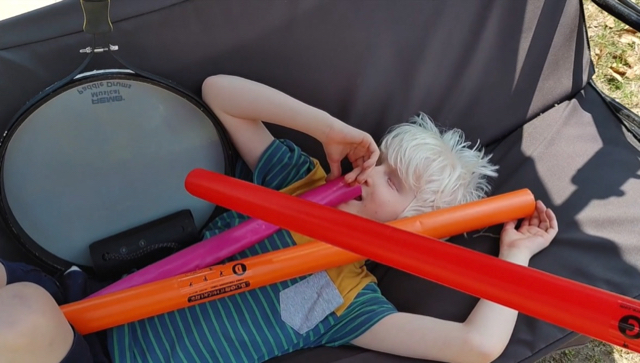
A deafblind elementary student enjoys the vibrations from amplified music and Boomwhacker-tuned percussion tubes.
The educational team that works with a deafblind student can support and facilitate the student’s motivation to communicate. Team members may include parents or guardians, caregivers, teachers, therapists, interveners, and the student themself. Because the student may miss motivating information in the environment, team members can provide opportunities for the student to access stimuli close at hand, like instruments in a music class. Team members may also need to assist in interpreting the stimuli in order to help the student develop the intrinsic and extrinsic motivation that will lead to meaningful engagement and communication. For example, a deafblind person may experience the sounds of a guitar or a drum being played with some adaptation or modified materials. A modification to the typical playing of a guitar or drum would be to allow and encourage students to put their head or other body parts in direct contact with an instrument while the instrument is being played.
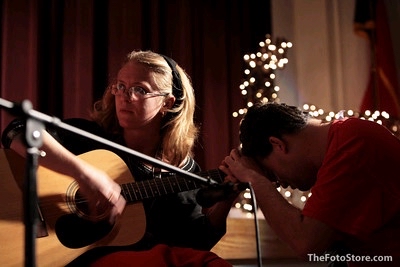
A student’s head and hands rest on the neck of a guitar in order to feel the vibrations while Dr. Darst plays at a holiday show at TSBVI.
Developing motivation to communicate is critical to emotional, cognitive, and physical growth. Motivation to communicate is fostered by a person’s experiences and the feedback they receive to their attempts to communicate. For example, if a deafblind child cries when wanting to be picked up by a caregiver, and they are picked up in response to the crying, they will begin to associate crying with being picked up. Repetition of this cause and effect sequence will reinforce the child’s motivation to communicate in this way—crying in order to be picked up.
The key to fostering positive motivation for communication is remembering that a deafblind person relies more upon what they smell, taste or feel than on what they see or hear (McInnes & Treffry, 1993). Stimuli, and the experiences related to them, will be the conduits for motivating a deafblind child to communicate about their perception, understanding, and use of the stimuli. If a deafblind child is consistently given positive reinforcement for their communication attempts, they will become more motivated to communicate. For example, if a deafblind child’s subtle attempts to communicate— such as moving their hand toward an object or turning their head toward the sound of a favorite melody—are received and acknowledged by the communication partner, then the child will begin to realize the relationship between their attempts to communicate and the partner’s responses. This reinforces them to make more communication attempts. If a child is not given positive reinforcement for communication attempts, or if the reinforcement is inconsistent, then their motivation to communicate is replaced with uncertainty and a feeling of being in flux physically, cognitively, and emotionally (McInnes & Treffry, 1993). For example, a child with typically-developing vision and hearing benefits from seeing their parent or caregiver approaching them and hearing the parent’s or caregiver’s voice long before they are touched or picked up. A deafblind child does not have the opportunity to anticipate being approached until they are actually being picked up. This inability to anticipate an interaction with the outside world can lead to constant guardedness, which can then lead to confusion, frustration, and even fear of what may happen (McInnes & Treffry, 1993). Educational team members must support the development of physical, mental and emotional stability for their deafblind students by creating reliable external motivators for communication. In a recent research study, music and music-related activities were found to be examples of reliable external motivators for communication for deafblind people.
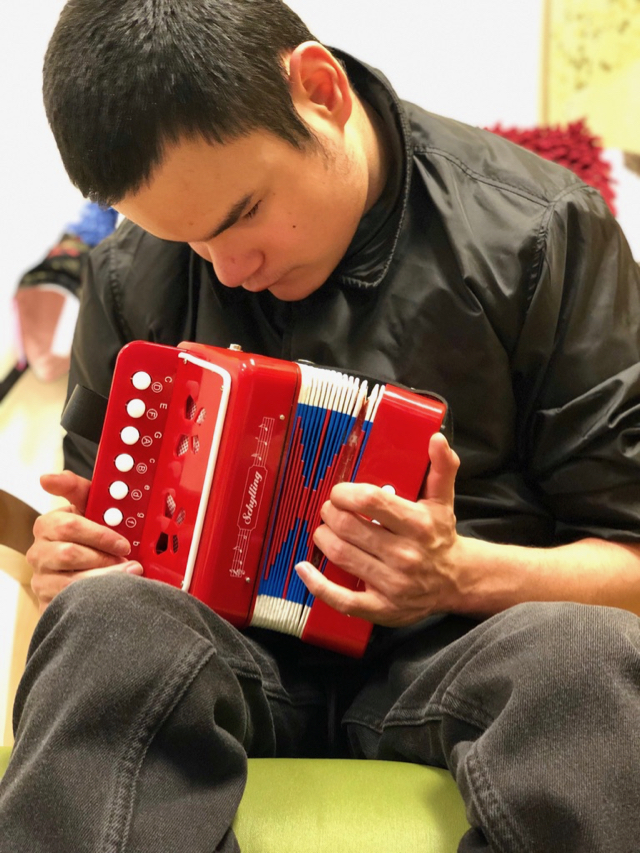
A deafblind secondary student at TSBVI plays an accordion.
The data from the study entitled, “Music As a Motivator for Communication for Students with Deafblindness,” provided evidence that music and music-related activities produced motivation for various types of communication in all three case study students who participated in the study. Sally, Mary, and Johnny were all diagnosed as deafblind, and all three students were diagnosed with visual functioning of minimal or no light perception. All three were also diagnosed with severe or profound bilateral hearing losses. At the time of the study, Sally and Mary were 13 years old, and Johnny was 18 years old. These three students participated in a daily adapted music class during which they were given opportunities to engage in the following music activities: co-active guitar strumming, drumming (solo and co-active), shaking of percussion instruments, use of a microphone and amplifier for singing/vocalization, hearing a song (included as part of strumming, drumming, shaking and singing/vocalizing), and keyboard playing. They had calendar checks with tactile-symbols between each activity.
Description of Activities from Study:
Co-Active Guitar Strumming
The student and a guitar-playing partner grasped an extra-large guitar pick (5 inches by 4 inches) and strummed the guitar strings together; the partner switched chords to assist the student in playing a song on a guitar.
Drumming
The student held one or two drum sticks or percussion mallets while striking a drum in a rhythmic pattern. Drumming was both solo drumming, where the student drummed alone/independently, and co-active drumming, where the student placed their hands on top of a partner’s hands while the partner struck the drums.
Shaking Percussion Instruments
The student held or tactually manipulated a percussion instrument like an egg shaker, tambourine, maraca, or other shakable instrument; shaking percussion instruments was both solo and co-active.
Use of Microphone and Amplifier for Singing/Vocalization
The student vocalized, spoke, or sang into a live microphone attached to an amplifier so that the vocalization was amplified and could be felt by the student if they made tactual contact with the amplifier while vocalizing.
Hearing a Song
The student was able to access some aspect of a song being played through loudspeakers in the music classroom. This was included as part of strumming, drumming, shaking and singing/vocalizing.
Keyboard Playing
The student wore headphones connected to an electronic keyboard, and the student was able to hear and/or feel the sounds coming from the keyboard when they pushed various keys and buttons on the keyboard.
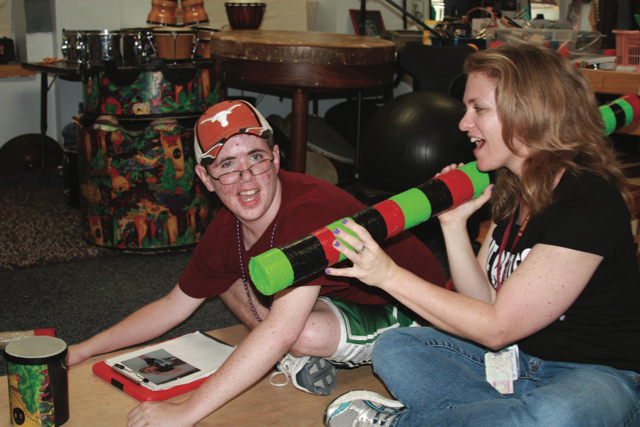
Dr. Darst interacts with a deafblind student during a music activity on a resonance board.
The Student’s Receptive and Expressive Communication Levels as Reflected During Music Activities
The students’ communications skills, as they related to each music activity, were classified using the following indicators from Communication Matrix by Charity Rowland (2011):
- Attention to faces, speech, and objects
- Turn-taking
- Anticipation of the next step in the activity
- Understanding cause-and-effect
- Sustaining joint attention
- Understanding facial expressions, tones of voice, and actions of others
- Imitation
Each student’s use of receptive and expressive communication skills was measured in relation to each activity in the music class routine. For Sally, the activities that elicited the most frequent and consistent communication were playing drums, playing a keyboard, and hearing a song. The activity that elicited the least amount of communication from Sally was use of the microphone. The communication skill she demonstrated most was attention to faces, speech, and objects, with objects being the focus of her communication. For Mary, the activities that elicited the most frequent and consistent communication were playing drums, playing a keyboard, and reading her calendar. The activity that elicited the least amount of communication from Mary was use of the microphone. The communication skill she demonstrated most was attention to faces, speech, and objects, with objects being the focus of her communication. For Johnny, the activities that elicited the most frequent and consistent communication were strumming the guitar, using the microphone, and reading his calendar. By the end of the study, Johnny had learned how to imitate chord progressions and could play them accurately for entire songs. The activity that elicited the least amount of communication from Johnny was shaking percussion instruments. The communication skill he demonstrated most was attention to faces, speech, and objects, with both attention to speech and objects being the foci of his skill demonstration.
Music as a Motivator for a Student to Communicate Expressively
All three students were consistently motivated to expressively communicate during these four activities: playing a keyboard, reading the activity calendar, playing drums, and hearing a song. Hearing a voice and using the microphone were the least motivating for Sally and Mary. Shaking percussion instruments was the least motivating activity for Johnny. All three students demonstrated all seven communication skill types during the study, including attention to an object, turn-taking, anticipation of the next activity, understanding cause-and-effect, sustaining joint attention, understanding the actions of others, and imitation. These results supported the premise that music and music-related activities can be motivational for expressive communication for deafblind students.
The Importance of Music as a Motivation for Deafblind Students
The study results support the premise that deafblind students can be motivated to communicate through music and music-related activities. The study results also support the fact that deafblind students can fully engage in various music-related activities with very little adaptation or modification to the activities themselves. This implies that deafblind students can benefit from participation in a music class with some adaptations and modifications to the general music class curriculum. The key to unlocking this motivation is finding the music activities that the students enjoy most and structuring activities that create an atmosphere for progress and learning. It is important for the Teacher of Students with Visual Impairments (TVI), the Teacher of Students who are Deafblind (TDB) and the classroom teacher to work with deafblind students in the music classroom because of the potential for bonding with the student, as well as the potential for observing growth and progress in the student’s skills in any and all areas of the Expanded Core Curriculum for Students with Visual Impairments (ECC).
References
Darst, S.D. (2014). Music as a motivator for communication for students with deafblindness. (Publication No. http://hdl.handle.net/2346/58677) [Doctoral dissertation, Texas Tech University]. Texas Tech University Library.
McInnes, J. M., & Treffry, J. A. (1993). Deaf-blind infants and children: A developmental guide. Toronto: University of Toronto Press.
Morreale, S. P., Spitzberg, B. H., & Barge, J. K. (2006). Human communication: Motivation, knowledge, skills. Belmont, CA: Thomas Wadsworth.
Rowland, C. (1996). Communication matrix. Portland: Child Development and Rehabilitation Center, Oregon Health Sciences University. Retrieved from http://www.communicationmatrix.org/Default.aspx.
Ryan, R. M., & Deci, E. L. (2000). Intrinsic and extrinsic motivations: Classical definitions and new directions. Contemporary Educational Psychology, 25, 54-67.
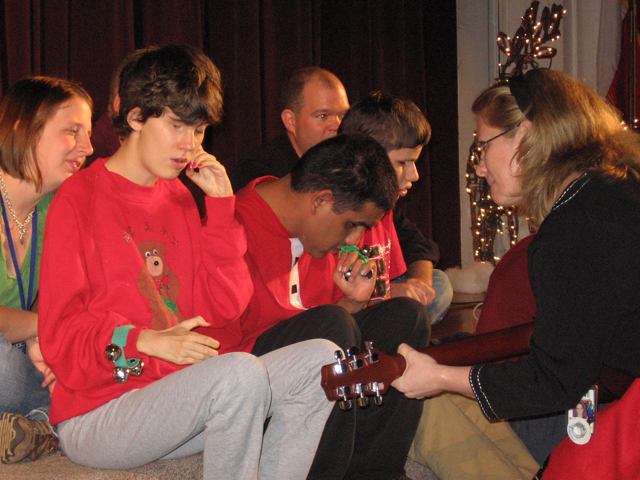
A deafblind student (in the middle) and TSBVI peers perform along with Dr. Darst during a Winter Holiday concert.
